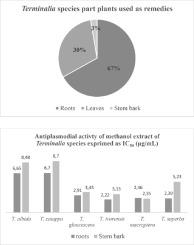当前位置:
X-MOL 学术
›
S. Afr. J. Bot.
›
论文详情
Our official English website, www.x-mol.net, welcomes your feedback! (Note: you will need to create a separate account there.)
Ethnobotanical and antiplasmodial investigation on Guinean Terminalia species
South African Journal of Botany ( IF 3.1 ) Pub Date : 2020-07-01 , DOI: 10.1016/j.sajb.2020.04.006 A.O. Baldé , E.S. Baldé , F. Bah , A. Camara , M.A. Baldé , A. Dramé , F. Dembélé , H. Barry , M.S. Traoré , A.M. Baldé
South African Journal of Botany ( IF 3.1 ) Pub Date : 2020-07-01 , DOI: 10.1016/j.sajb.2020.04.006 A.O. Baldé , E.S. Baldé , F. Bah , A. Camara , M.A. Baldé , A. Dramé , F. Dembélé , H. Barry , M.S. Traoré , A.M. Baldé

|
Abstract Context and Aim Species of the Terminalia (Combretaceae) are used worldwide in traditional medicine to treat different kinds of diseases. Among the 30 Terminalia species described in Africa, 11 have been reported in the flora of Guinea by Lisowski. In the present work, a summary of the traditional uses and antiplasmodial activity of 6 Terminalia species is presented. Methods Six voucher specimens of Terminalia species (T. albida, T. catappa, T. glaucescens, T. ivorensis, T. macroptera and T. superba) collected across the country were used during a semi-structured interview with traditional healers. Knowledge of these plants and their medicinal uses was collected. Methanolic extracts of the roots and stem bark of the 6 Terminalia species were prepared and tested for their antiplasmodial activity. Results among the hundred traditional healers interviewed, (91) knowed T. albida, (48) T. catappa, (24) T. glaucescens, (8) T. ivorensis, (7) T. macroptera and (1) T. superba. Terminalia species were used against several diseases among this malaria, hemorrhoids, skin diseases, jaundice. The roots and stem bark of T. glaucescens, T. ivorensis, T.macroptera and T. superba showed strong antiplasmodial activity in vitro (IC50 ≤ 5 μg/mL). The roots and stem bark of T. albida and T. catappa, showed good antiplasmodial activity (5 μg/mL≤ IC50 ≤ 10 μg/mL). Discussion and conclusion Traditional healers in Guinea, like Traditional healers in the worldwide used Terminalia species, for many applications including treating malaria, hemorrhoids, skin diseases, jaundice. The data from antiplasmodial activity of theses Terminalia species could explain the traditional use against malaria. More investigations have engaged to further investigation of T. albida mainly against malaria.
中文翻译:

几内亚榄仁树种的民族植物学和抗疟原虫研究
摘要 榄仁科(Combretaceae)的背景和目的种在世界范围内用于传统医学以治疗不同种类的疾病。在非洲描述的 30 种榄仁树种中,Lisowski 在几内亚的植物群中报道了 11 种。在目前的工作中,总结了 6 种榄仁树的传统用途和抗疟原虫活性。方法在与传统治疗师的半结构化访谈中,使用了在全国收集的六种榄仁树种(T. albida、T. catappa、T. glaucescens、T. ivorensis、T. macroptera 和 T. superba)的凭证标本。收集了这些植物及其药用的知识。制备了 6 种榄仁树的根和茎皮的甲醇提取物,并测试了它们的抗疟原虫活性。接受采访的一百名传统治疗师的结果,(91) 知道 T. albida,(48) T. catappa,(24) T. glaucescens,(8) T. ivorensis,(7) T. macroptera 和 (1) T. superba . 榄仁树被用于治疗疟疾、痔疮、皮肤病、黄疸等多种疾病。T. glaucescens、T. ivorensis、T.macroptera 和 T. superba 的根和茎皮在体外表现出很强的抗疟原虫活性(IC50 ≤ 5 μg/mL)。T. albida 和 T. catappa 的根和茎皮表现出良好的抗疟原虫活性(5 μg/mL≤ IC50 ≤ 10 μg/mL)。讨论和结论 几内亚的传统治疗师,如世界范围内的传统治疗师使用的榄仁树种类,用于许多应用,包括治疗疟疾、痔疮、皮肤病、黄疸。来自这些榄仁树物种抗疟原虫活性的数据可以解释抗疟的传统用途。更多的调查已参与进一步调查 T. albida 主要对抗疟疾。
更新日期:2020-07-01
中文翻译:

几内亚榄仁树种的民族植物学和抗疟原虫研究
摘要 榄仁科(Combretaceae)的背景和目的种在世界范围内用于传统医学以治疗不同种类的疾病。在非洲描述的 30 种榄仁树种中,Lisowski 在几内亚的植物群中报道了 11 种。在目前的工作中,总结了 6 种榄仁树的传统用途和抗疟原虫活性。方法在与传统治疗师的半结构化访谈中,使用了在全国收集的六种榄仁树种(T. albida、T. catappa、T. glaucescens、T. ivorensis、T. macroptera 和 T. superba)的凭证标本。收集了这些植物及其药用的知识。制备了 6 种榄仁树的根和茎皮的甲醇提取物,并测试了它们的抗疟原虫活性。接受采访的一百名传统治疗师的结果,(91) 知道 T. albida,(48) T. catappa,(24) T. glaucescens,(8) T. ivorensis,(7) T. macroptera 和 (1) T. superba . 榄仁树被用于治疗疟疾、痔疮、皮肤病、黄疸等多种疾病。T. glaucescens、T. ivorensis、T.macroptera 和 T. superba 的根和茎皮在体外表现出很强的抗疟原虫活性(IC50 ≤ 5 μg/mL)。T. albida 和 T. catappa 的根和茎皮表现出良好的抗疟原虫活性(5 μg/mL≤ IC50 ≤ 10 μg/mL)。讨论和结论 几内亚的传统治疗师,如世界范围内的传统治疗师使用的榄仁树种类,用于许多应用,包括治疗疟疾、痔疮、皮肤病、黄疸。来自这些榄仁树物种抗疟原虫活性的数据可以解释抗疟的传统用途。更多的调查已参与进一步调查 T. albida 主要对抗疟疾。



























 京公网安备 11010802027423号
京公网安备 11010802027423号